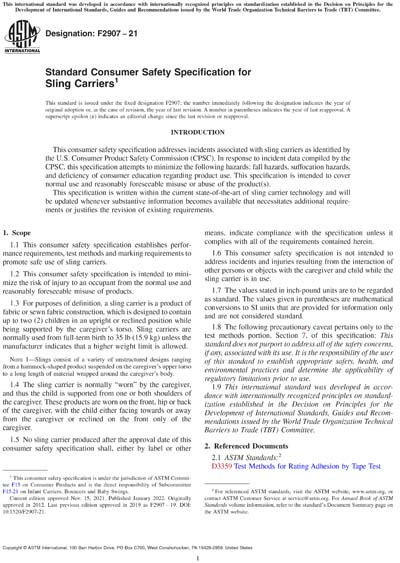Historical
ASTM F2907-21
Standard Consumer Safety Specification for Sling Carriers
1.1This consumer safety specification establishes performance requirements, test methods and marking requirements to promote safe use of sling carriers.
1.2This consumer safety specification is intended to minimize the risk of injury to an occupant from the normal use and reasonably foreseeable misuse of products.
1.3For purposes of definition, a sling carrier is a product of fabric or sewn fabric construction, which is designed to contain up to two (2) children in an upright or reclined position while being supported by the caregiver's torso. Sling carriers are normally used from full-term birth to 35 lb (15.9 kg) unless the manufacturer indicates that a higher weight limit is allowed.
Note 1:Slings consist of a variety of unstructured designs ranging from a hammock-shaped product suspended on the caregiver's upper torso to a long length of material wrapped around the caregiver's body.
1.4The sling carrier is normally "worn" by the caregiver, and thus the child is supported from one or both shoulders of the caregiver. These products are worn on the front, hip or back of the caregiver, with the child either facing towards or away from the caregiver or reclined on the front only of the caregiver.
1.5No sling carrier produced after the approval date of this consumer safety specification shall, either by label or other means, indicate compliance with the specification unless it complies with all of the requirements contained herein.
1.6This consumer safety specification is not intended to address incidents and injuries resulting from the interaction of other persons or objects with the caregiver and child while the sling carrier is in use.
1.7The values stated in inch-pound units are to be regarded as standard. The values given in parentheses are mathematical conversions to SI units that are provided for information only and are not considered standard.
1.8The following precautionary caveat pertains only to the test methods portion, Section 7, of this specification: This standard does not purport to address all of the safety concerns, if any, associated with its use. It is the responsibility of the user of this standard to establish appropriate safety, health, and environmental practices and determine the applicability of regulatory limitations prior to use.
1.9This international standard was developed in accordance with internationally recognized principles on standardization established in the Decision on Principles for the Development of International Standards, Guides and Recommendations issued by the World Trade Organization Technical Barriers to Trade (TBT) Committee.
ASTM International [astm]

